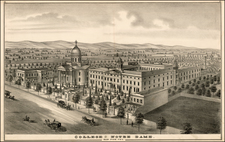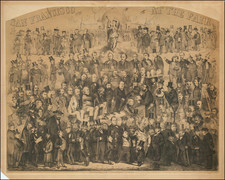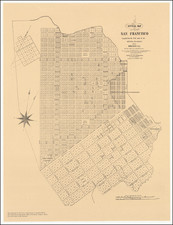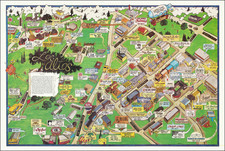Decorative pair of views of the properties of John Hall in Alvarado (now Union City), California.
John Hall
John Hall, an Ohio native born in 1822, settled in Alvarado in the early 1860s, acquiring a large ranch where he raised and showed thoroughbred horses from 1864. His success in breeding and raising thoroughbreds was highlighted at the 1871 California State Fair, where he garnered multiple awards, including best stallions and mares in various age categories, and for the best thoroughbred dam with her colts. One of his notable horses, Peggy Ringgold, and her offspring also received accolades at the fair. In 1873, John Hall sold the mare Alice May for $1,500 to Mr. Samuels of Livermore.
Hall Ranch Park, located on the west side of Union City, reflects the historical significance of the area once known as Hall Ranch, now the site of the Contempo housing subdivision. Originally, Dyer Street west of Alvarado Boulevard was called Hall Ranch Road, indicating the expanse of John Hall's property.
The South Pacific Coast Railroad, which traversed Alvarado and crossed Hall's property, established a rail stop named "Hall Station" on his land, near the current crossing of Alvarado Boulevard. In 1865, Hall planted three Eucalyptus trees near this station; they were reported to still be standing in 1936 but have since disappeared. In 1912, the ranch changed hands when R. B. Mott purchased it, subsequently subdividing and selling the land into smaller farms and ranches.
Alvarado
The history of Alvarado, California, is rooted in the mid-19th century development of Alameda County. The original settlement, founded in 1851 and initially named New Haven, was established by Henry C. Smith, who named it after his father's hometown in Connecticut. This early settlement marked the beginning of permanent residential and agricultural development in the area.
In 1853, New Haven merged with the nearby settlement of Alvarado, taking on the latter's name. This newly unified town was named in honor of Juan Alvarado, a notable figure in Californian history who served as the Mexican Governor of California from 1836 to 1842. The same year, Alvarado became the county seat of the newly formed Alameda County, establishing its early political and administrative significance. The first post office in Alvarado was established in 1853, further anchoring its status as a burgeoning community center.
Alvarado's early economy was largely driven by agriculture, capitalizing on the region's fertile land. Significant contributions to its development were made by local entrepreneurs like John Horner, who developed agricultural systems and infrastructure, contributing to the town's growth and sustainability. Horner's efforts facilitated the establishment of Alvarado as a critical distribution point along the bay for agricultural products bound for San Francisco.
Despite its early importance, Alvarado's status as the county seat was relatively short-lived. However, the area remained economically significant due to its agricultural production and strategic location. The town's narrative took a turn on January 13, 1959, when Alvarado and Decoto, another local community, voted to incorporate as Union City. This marked the end of Alvarado as a standalone entity and the beginning of its history as part of a larger, unified urban area.














